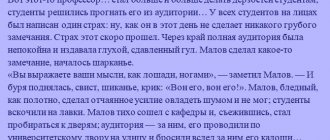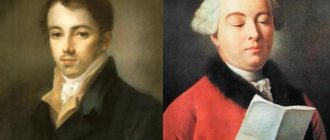Childhood and youth
Mikhail was born on November 8 (19), 1711 in the small village of Mishaninskaya, which was located in the Arkhangelsk province. The boy was very hardworking and inquisitive from childhood. He helped his father, who owned a ship and transported private and government cargo on it.
He began to learn the basics of literacy only at the age of 12. Misha's mentor was Ivan Shubny, whose son Fedot Shubin later became a famous sculptor. Semyon Sabelnikov, who served as a clerk at the Kholmogory bishop’s court, also took part in Lomonosov’s training. Two years later, the boy mastered the basics of competent writing and reading.
Mikhail's passion for books was not supported in his home. Constant conflicts with his stepmother on this basis made the young man’s life simply unbearable.
After some time, Lomonosov learned that his father was going to marry him. He had to pretend to be sick to postpone the wedding. After these events, the young genius decided to go to Moscow.
early years
Mikhail Lomonosov was born on November 8 (19), 1711 in the village of Mishanskaya (Arkhangelsk province, now the village of Lomonosovo) into a wealthy family. From an early age he loved to go to sea with his father. These voyages influenced the formation of young Lomonosov’s ideas about the beauty of nature and strengthened his character.
Lomonosov managed to learn literacy and reading as a child. At the age of 14, Mikhail already knew how to write correctly. Having learned that his father wants to marry him, at the age of 19 he decides to flee to Moscow.
Educational institutions in Lomonosov's biography
Mikhail ran away from home in December 1730. He took with him some clothes, books donated by a neighbor, and went on foot to the capital. On the way, he was lucky enough to meet a fish train, with which he continued on his way.
He managed to get to Moscow only three weeks later, at the beginning of 1731. To enter the Slavic-Greek-Latin Academy, the young man had to say that he was the son of a Kholmogory nobleman and forge documents.
It was not easy for him in school. The lack of money provoked ridicule from classmates. However, thanks to his great thirst for learning and unique abilities, six months later the boy was already transferred to the second grade, and almost immediately to the third.
Lomonosov devoted a lot of time to self-education. He studied ancient chronicles, patristics and other theological literature in one of the monasteries. He was also interested in ancient Russian books of various genres, publications of philosophical, technical and secular content.
Thanks to the Moscow Academy, Mikhail was able to receive a humanitarian education. However, Lomonosov did not want to stop there, because he had a great interest in the natural sciences. He decided to continue his studies at the Kiev-Mohyla Academy, but stayed there for only a few months. He was lucky enough to learn the basics of technical and natural sciences in St. Petersburg, where he was sent after returning to Moscow from Kyiv.
Education in Russia
The journey to Moscow lasted about three weeks. To enter the Slavic-Greek-Latin Academy (Spassky Schools) in 1731, the young man created fake documents and appeared before the admissions committee as the son of a Kholmogory nobleman. Diligence and an incredible love for studying everything unknown allowed me to complete two courses of study in one year.
Within the walls of the educational institution, Mikhail studied the humanities and languages. But in 1734, he thought about continuing his studies at the Kiev-Mohyla Academy and immediately turned to the academy’s leadership about transferring to Kyiv for a year. He really missed essays on physics and mathematics. The translation was approved and financial assistance was provided. But even there he did not find any information of interest. Therefore, I carefully studied the chronicles and texts of the holy fathers.
Scientific activity
During his training, Lomonosov quickly distinguished himself. He was sent to Germany among the best students. There he studied chemistry, physics, mining and metallurgy. He also devoted time to foreign languages, dancing, drawing, fencing and literature. During the five years that he spent abroad, Mikhail wrote his first poems, several scientific works, and translated the works of foreign academicians into Russian.
The young scientist decided to return to Russia in 1740, but on the way home he was forcibly recruited into the Prussian army. Since service was not part of his plans, he was forced to desert.
Arriving a year later in St. Petersburg, he began working at the Academy in the department of natural science. His supervisor was Professor Amman. At this time, he was collecting minerals and other fossils for the Kunstkamera and working on a treatise in Latin.
Lomonosov approached writing scientific dissertations with particular seriousness, which were subsequently highly appreciated by the Academy of Sciences. In this educational institution, Mikhail became an adjunct of the Physics class. After taking office, he was able to conduct scientific research on his own.
In 1745, Lomonosov addressed a meeting of academicians with a request to award him the degree of professor of chemistry for four new dissertations that he wrote over several years. Having received approval from the best scientists, he began teaching at the university and also gave public lectures on physics. He also created scientific treatises in Latin.
A special place in his biography was occupied by literary creativity, including poems about events of a state nature. The scientist’s business was going well; a house was built for him using government funds, and then the first chemical laboratory in Russia.
At the age of 37, Mikhail began editing translations of foreign literature, which were published in the publishing house at the Academy of Sciences, as well as notes in the publication “St. Petersburg Gazette”. Despite the fact that Lomonosov spent a lot of energy disseminating the works of foreign authors, he also found time for the development of domestic science.
He became the author of the first textbook “Rhetoric”, which was published in Russian. During these same years, Lomonosov addressed Empress Elizabeth with a “Speech of Honor,” thanks to which he later received the position of collegiate adviser.
Having secured the support of the empress, the scientist opens a mosaic factory, of course, not without the help of I. Shuvalov. The Empress granted Lomonosov the Ust-Ruditsa manor, as well as four villages adjacent to it.
The scientist also plans to conduct experiments with electricity, for which he asks permission from Elizaveta Petrovna. He is also concerned about the fate of the family of Professor G.V. Richman, who died during physical experiments, for which he asked for a pension.
In 1757, the brilliant scientist published one of the most remarkable works, “The Tale of the Birth of Metals from the Earth’s Shaking.” Outstanding scientific works of that period include such works as “On the Layers of the Earth”, “Discourses on the Great Precision of the Sea Route”, “The First Foundations of Metallurgy or Mining”. At the same time, Lomonosov involved the leadership of the Academy in carrying out reforms in the field of education, thanks to which talented young people who did not belong to a high class were able to study at the educational institution.
A significant event in his biography was his resignation from the Department of Chemistry, which was associated with receiving the U. Salkhov Prize for solving a problem announced by the Academy of Sciences. This hasty decision deprived Lomonosov of the opportunity to conduct experiments within the walls of a scientific institution, and he had to study chemistry in his home.
The new work that he presented to the public in 1764 contained a brief description of various voyages along the Northern Seas, as well as information about the possible existence of a passage from the Siberian Ocean to India. His scientific work was taken as a basis when drawing up the route of the expedition setting off in search of a route to India through the North Seas.
Especially for organizing this expedition, Lomonosov created a “night telescope” for a detailed overview of the area at night. Despite the scientist’s efforts, this and other expeditions ended in failure; brave researchers tried in vain to break through the dangerous ice.
After Catherine II ascended the throne, the scientist’s position became rather precarious, since he was always devoted to the late Elizabeth Petrovna. However, the situation changed after the new empress became acquainted with some of the scientific works of the great scientist. She even granted him the rank of state councilor.
Popular message topics
- Pollution of the world's oceans
The surface of the globe can be divided into four parts, one of which is occupied by land, and the remaining three of the four are covered by water. These three parts of the earth's surface that are under water are conventionally considered the world's oceans. - Plants of the Krasnodar region
In the southwestern part of Russia there is a wonderful region. Its name is Krasnodar region. There is a special nature here with its flora and fauna. Thanks to its temperate climate, the territory of the Krasnodar Territory is characterized by warm - Amaranth flower
Many people think that amaranth is an ornamental plant. And that’s all, because it usually grows in flower beds, front gardens or in city parks. A similar plant grows in Russia, which has several names.
Personal life of Mikhail Lomonosov
The girl Elizaveta Tsilch, the daughter of the owner of the apartment in which Lomonosov lived during his trip to Germany, managed to win the heart of a talented scientist from Russia. Mikhail liked her for her complaisance, sincerity and homeliness. The man looked closely at the young girl, who at that time was only 19 years old, for a long time. Gradually, the sudden passion grew into a deep feeling. It became something special and unique for Lomonosov. Later he even wrote about him: “Love is the inclination of the spirit towards another person in order to have pleasure from his well-being.”
The young people's first declaration of love happened only two years after they met. Lomonosov could not help but realize that, connecting his life with a German girl, he would have to face many problems and trials. In addition, his chosen one was of a different faith.
In 1739, Mikhail and Elizabeth got married, but did not get married in church. In the same year, the couple had a daughter, Katerina-Elizabeth. Despite the fact that she was born in marriage, the birth certificate indicated that she was illegitimate. This was explained by the fact that the union was civil, not church.
In May 1740, the wedding ceremony did take place. After this, Mikhail Vasilyevich decided that living together with his wife would be more prosperous in Russia, since at home he could engage in scientific research.
Since Elizabeth's mother was seriously ill, it was decided that Lomonosov would go to St. Petersburg alone and then send money for the move. After her husband's departure, Elizaveta Zilch gave birth to a boy, whom she named Johannes. The baby was born sickly and died a month later. Soon the girl’s mother also died. Tragic events pushed her to move quickly.
Elizabeth with her daughter and brother arrived in St. Petersburg in 1743. The couple's love survived the test of separation. Lomonosov turned out to be a monogamous man; there were no more serious relationships with other women in his life.
The first years of living together in Russia turned out to be very difficult. Lomonosov's eldest daughter died, his salary was barely enough to make ends meet. The Lomonosovs received their own two-story house, built according to a standard design “for eminent citizens,” only in the second half of 1757. It was located in the city center, and its façade overlooked the Moika River. Later, a pond was built in the courtyard of the house and an astronomical observatory was built.
The youngest daughter Elena Lomonosova was born in 1749. She grew up as a beautiful and educated girl, studied foreign languages, was interested in music and literature, married a librarian of the Imperial Library and gave birth to three daughters and a son. However, family happiness was short-lived; the girl died young, when she was only 23 years old.
Personal life of Mikhail Vasilievich
As you know, while a student, Lomonosov lived abroad for some time, namely in Germany. In the city of Marburg, twelve of the best students moved into apartments rented out by Elisabeth-Christina Zilch. After living there for some time, Lomonosov met the owner’s daughter, Elizaveta. The age difference between them was almost nine years, but this did not stop them from getting married.
At the end of 1739, Elizabeth was already carrying a child from Mikhail Vasilyevich. Soon a daughter, Catherine, was born, but according to the law she was considered illegitimate. We have already said that Lomonosov really wanted to return to Russia. When he succeeded, Elizabeth was pregnant again. A son was born, who was named Ivan.
A series of events occurred as a result of which Elizabeth was able to find Mikhail Vasilyevich in Russia. He did not deny the fact of marriage. The couple moved to St. Petersburg, where they lived happily. However, this did not last long; another tragedy occurred in the family. In 1743, Catherine, the first daughter of Mikhail Vasilyevich and Elizabeth, died.
Lomonosov's creativity is so multifaceted that a whole book could be written. In this article we tried to touch on the most complex and interesting topics. Many people still consider Lomonosov the greatest scientist, and not without reason.
Scientific heritage
The outstanding Russian scientist made many discoveries in the field of physics, chemistry and astronomy, several decades ahead of Western European scientists. His main achievements include the following:
- Lomonosov made an enormous contribution to the development of the teachings of electricity, heat, geology, meteorology and optics. Thanks to scientific experiments with glass, he managed to create a unique Russian mosaic, which everyone now knows about.
- He discovered the law of conservation of matter, which summarizes all his previous observations.
- He formulated with high precision all the basic principles of the kinetic theory of gases.
- Revealed that the northern lights are actually electrical in origin. He is the author of the theory of colors, as well as the basic theory of vertical atmospheric currents.
- Discovered the atmosphere of the planet Venus. He succeeded in this thanks to a reflective telescope, unique for that time, which Lomonosov created with his own hands. Even then, he was sure that the solar surface was boiling, and the formation of tails on comets occurred under the influence of the energy of the Sun.
- He devoted a lot of time to the development of the Russian scientific language, which appeared shortly before the start of the scientific research of the famous scientist. He was engaged in streamlining foreign terminology, adapting it in such a way that it was as clear as possible and did not lose its original meaning.
- He wrote many works in poetic form, and also made many poetic translations.
- He published a number of poetic works, as well as poetic translations.
- Gave answers to many questions about the origin of most minerals and minerals.
- He wrote several famous scientific works in the field of history.
The most interesting facts from the life of Lomonosov
Lomonosov’s biography is difficult to even compare with any other representative of the 18th century intelligentsia who devoted his life to science. The most interesting and unexpected facts about the most talented Russian scientist include the following:
- Mikhail had a violent temper. His mood very quickly changed from very good-natured to too furious. When he was dissatisfied with something, he could use a stick. There is a known case when Lomonosov beat three people who wanted to rob him.
- In Germany, he studied the art of fencing, thanks to which he earned the respect of local youth.
- Lomonosov was ranked among the most outstanding scientists of the 18th century.
- He was the first to scientifically substantiate the existence of the southernmost continent of the Earth - Antarctica.
- He preferred dishes that were made from fish.
- In a fit of rage, he broke the nose of one academician with whom he had an argument.
- He spoke 12 languages, sometimes for the sake of a joke he could pretend to be a foreigner.
- He was not distinguished by neatness in his clothes; he could not take off his favorite robe, even when noble nobles visited him.
- In ordinary life, he often spoke using common expressions, and could, if desired, even use obscene language. However, this did not mean that his speech was poor. He could easily outshine any nobleman of the highest rank in conversation.


